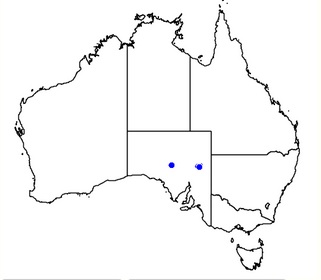Acacia araneosa
Contents
General Plant Info
Acacia araneosa, also known as "Spidery Wattle" or "Balcanoona Wattle", is a small, erect, wispy tree, 3–8 m high.
Spidery Wattle is known from Gammon Ranges National Park and Arkaroola Sanctuary. The species is also cultivated in the Botanic Gardens of Adelaide, South Australia. A reported hybrid of the Spidery Wattle with Silver Wattle Acacia rivalis, occurs within the main population, near Nudlamutana Well (Orchard & Wilson 2001).
Spidery Wattle has a population of approximately 1000 individuals, and is listed as endangered (National Parks and Wildlife Act 1972 (South Australia): June 2011)
Spidery Wattle flowers are produced irregularly throughout the year (Jessop & Toelken 1986; Leigh et al. 1984; Whibley & Dashorst 1985; Whibley & Symon 1992) whilst fruiting is recorded in October and November (Whibley 1976). The species often occurs in dense stands (Whibley & Dashorst 1985). Frequent juveniles have been observed at Arkaroola, which indicates healthy recruitment.
Geographic distribution
Acacia araneosa is restricted to a small area of northern Flinders Ranges in South Australia. It is confined to Vulkathunha–Gammon Ranges National Park and the adjacent Arkaroola Sanctuary. The species has an estimated extent of occurrence of 8 km2.
Identification
Phyllodes are pendulous, thickly filiform (thread-like), 18–35 cm but sometimes up to 69 cm long, usually 1–2 mm wide, delicately narrowed at the apex, and most often smooth though sometimes with a scale-like texture on the surface.
Inflorescences are bunched along a stalk 7–10 mm long, with globular heads of 50–70 flowers, which are small, yellow and arranged in groups of five.
Pods are linear, somewhat constricted between seeds, and approximately 14.5 cm long by 4–6 mm wide, smooth and leather or paper like in texture. Seeds are dull to slightly shiny, black and 4.5 mm long.
Branchlets are slender, flexuose (bendy and winding), smooth and red-brown in colour.
Alkaloid content
Other uses
Extraction
Cultivation
Acacia araneosa grows on calcareous soil on hillsides and ridges. Associated vegetation is dry open woodland of Curly Mallee (Eucalyptus gillii) and Porcupine Grass (Triodia irritans) (Orchard & Wilson 2001; Whibley 1976; Whibley & Dashorst 1985; Whibley & Symon 1992). The soil is a crusty alkaline neutral red duplex. The annual rainfall average is about 200 mm (Whibley & Symon 1992).
Suppliers
Links
http://www.environment.gov.au/cgi-bin/sprat/public/publicspecies.pl?taxon_id=20767
